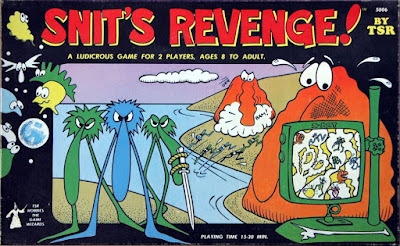Retrospective: Snit's Revenge
 Last month, I wrote a post in which I briefly sang the praises of Tom Wham, whom I called an underappreciated game designer. When I wrote that, I cited a few examples of his designs that I remember playing in my youth and was surprised to discover that I had never, in the more than 270 retrospective posts I've made over the years, written one about Snit's Revenge. This surprised me multiple reasons, not least of which being that I probably played Snit's Revenge almost as often as I played The Awful Green Things from Outer Space (my favorite Tom Wham game). Still, it was strangely pleasing for a TSR fanboy like myself to discover I still had a few more memories left to mine for blog content.
Last month, I wrote a post in which I briefly sang the praises of Tom Wham, whom I called an underappreciated game designer. When I wrote that, I cited a few examples of his designs that I remember playing in my youth and was surprised to discover that I had never, in the more than 270 retrospective posts I've made over the years, written one about Snit's Revenge. This surprised me multiple reasons, not least of which being that I probably played Snit's Revenge almost as often as I played The Awful Green Things from Outer Space (my favorite Tom Wham game). Still, it was strangely pleasing for a TSR fanboy like myself to discover I still had a few more memories left to mine for blog content.I first encountered Snit's Revenge in its 1980 boxed set form, which I purchased at Kay-Bee Toys sometime in 1981 or '82. This is actually the third version to appear under the auspices of TSR, the first being in the pages of Dragon magazine (December 1977) and the second a smaller boxed game (1978) similar in size to the original release of Dungeon! The 1980 version had pretty good production values and generally looked more like the kind of "family boardgame" published by Parker Brothers or Milton-Bradley, which makes sense, given TSR's ambitions to broaden their audience beyond the teenagers and college students who were D&D's primary customers.
Like many Tom Wham games, Snit's Revenge is a two-player game, with one of the players taking the role of the titular Snits and the other their mortal enemies the Bolotomi – or rather the immune system of a single Bolotomus, as it attempts to fend off an infestation (infection?) of Snits. Wham amusingly provides a backstory for this situation in the form of a comic in which he shows how a deity, Embraz the Bulbous, created a world to alleviate his boredom. Eventually, Embraz seeks the aid of his fellow gods to make "something new" for the world he created, leading to the creation of the immense Bolotomi and the tiny Snits. The Bolotomi enjoyed nothing more than smashing Snits, but the Snits were gifted with the ability to reproduce quickly, which enabled them to enter the bodies of Bolotomi and attempt to destroy their "spark of life" from within.
If this all sounds silly and bizarre, it is, but what else would you expect from a Tom Wham game? Basic gameplay is quite simple, with the Snit player attempting to destroy the internal organs of the Bolotomus, one of which holds the aforementioned "spark of life." Destruction of that organ results in the death of the Bolotomus and victory for the Snit player. The Bolotomus player attempts to mount a defense against the Snits with Snorgs, which act like leukocytes in the human body. In the advanced version of the game, the Bolotomus player has additional defenses at his disposal, such as Makums and Runnungitms, while the Snit player Supersnits, which are hardier and generally more dangerous. In both versions of the game, the main advantage of the Snit player is numbers; indeed, he does not need to reveal just how many Snits he has in his invasion force and this uncertainty hampers the decisions of the Bolotomus player.
Snit's Revenge has a bit less replayability than The Awful Green Things in my experience, owing to a smaller board and fewer random elements. Likewise, it's unconventional subject matter is perhaps not quite as appealing as the straightforward B-movie scenario of The Awful Green Things. Even so, my friends and I had fun with it. A complete game could be played in no more than 30 minutes and it wasn't uncommon to do so in even less time. That made it perfect for playing while we waited for our RPG group to assemble in someone's basement.
Published on March 02, 2022 10:30
No comments have been added yet.
James Maliszewski's Blog
- James Maliszewski's profile
- 3 followers
James Maliszewski isn't a Goodreads Author
(yet),
but they
do have a blog,
so here are some recent posts imported from
their feed.



